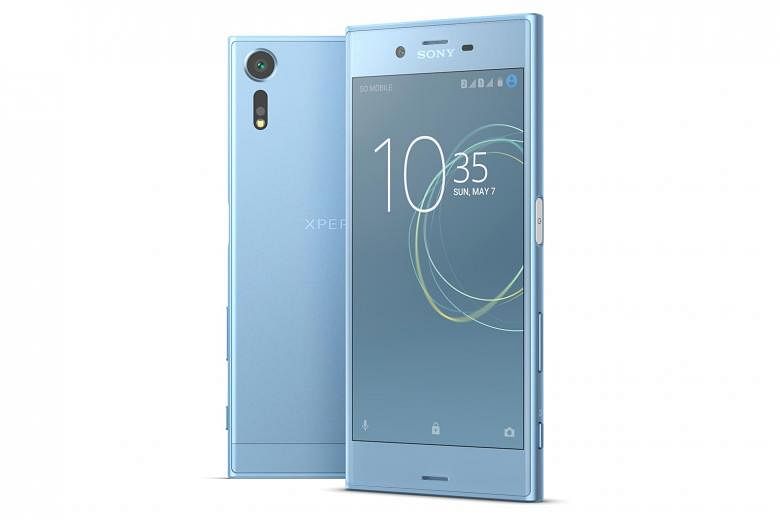Sony's first smartphone of the year, the Xperia XZs, is, surprisingly, not the Japanese firm's 2017 flagship.
At a time when other smartphone manufacturers are launching their premium flagships, Sony is still playing it coy, saving its top-end Xperia XZ Premium for a launch later in the year.
It feels like the XZs is a tantalising appetiser to the main course in a dining hall where other tables are already waiting for dessert.
However, the XZs holds its own against the premium flagships released so far, as it is basically a compact version of the XZ Premium that does away with a 4K screen for a smaller form factor.
At first glance, it is hard to tell the XZs apart from last year's Xperia XZ. There are a few tell-tale clues, like the realignment of the power, volume and camera button lower on the right edge of the phone, but the XZs' rounded body shape along its sides and hand-feel follow the same design trend of last year's models.
-
TECH SPECS
-
PRICE: $898
PROCESSOR: Qualcomm Snapdragon 821 Processor (Dual-core 2.15 GHz, dual-core 1.6 GHz)
DISPLAY: 5.2-inch Full HD, 1920 x 1080 pixels, 424 ppi pixel density
OPERATING SYSTEM: Android 7.1 Nougat
CAMERA: 19MP, f/2.0 (rear); 13MP, f/2.0 (front)
MEMORY: 64GB (microSD expandable up to 256GB), 4GB RAM
BATTERY: Non-removable 2,900mAh
-
RATING
-
FEATURES: 4/5
DESIGN: 3/5
PERFORMANCE: 5/5
BATTERY LIFE: 4/5
VALUE FOR MONEY: 4/5
OVERALL: 4/5
The fingerprint sensor is still on the phone's power button, which is quite nifty when picking the phone up with the left hand as that's where the index finger will rest naturally.
Unfortunately, this makes the XZs look painfully dated next to its competitors, due to the relatively large bezels on the top and bottom of the front screen at a time where other phones are slowly perfecting the bezel-less look.
But look under the hood and the XZs redeems itself somewhat with a new camera sensor technology. It is still a tough sell, though, in a market where consumers are demanding the best-looking phone out there since that is what they will be looking at all the time.
The biggest feature Sony added to the XZs is what the company calls a triple-stacked memory sensor, which is a component usually found in compact cameras.
This sensor allows the XZs to record and process images at very high speeds, leading to its camera being able to do two cool things: super-slow-motion capture of up to 960 frames per second and predictive capture that snaps shots even before you hit the shutter button.
This ups the strength of the XZs 19-megapixel rear camera, which is a potent-enough shooter that takes sharp and clear photos, with colours that tend towards the warmer side of the spectrum but with good dynamic range.
The super-slow-motion mode is able to take vivid shots of things that happen within the blink of an eye, such as a balloon bursting or the flaring of a matchstick, in beautiful, impressively dramatic slow motion.
It works best in bright natural lighting, as the flicker of lightbulbs will distort the video. This does limit the number of chances you'll get to use the mode. It also takes some skill and trial and error to hit the slow-mo capture button in time to snap the event, which makes it work best when shots are planned beforehand.
The phone's predictive capture feature lets users shoot the exact moment something happens. The sensor is able to sense motion when readying a shot and will save cached images while doing so, which lets it capture shots of things that happen milliseconds before the shutter button is even pressed.
This mode generates four different photos so users can choose the best shots of the event that was captured. In most of my tests, which involved taking pictures of my brother shooting a piece of folded-up paper from a rubber band slingshot, the XZs was able to pinpoint the time of launch just about half of the time, making the feature still quite reliant on good timing and a bit of luck.
Aside from the novel uses of the XZs' new sensor, there is not much that differentiates the phone from Sony's previous flagship.
The software remains relatively clean, save for the usual Sony apps, along with Sony's acclaimed battery-saving tech that lets me eke out a good three to four hours more of battery life when I switched it to Stamina mode.
• Verdict: While the Xperia XZs may not be Sony's flagship, it packs new camera technology that might impress smartphone photographers out there.


